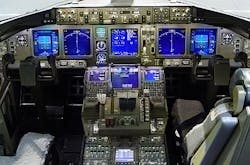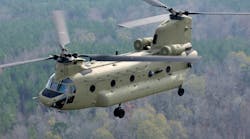MUNICH, 22 March 2012.Avionics experts from Teledyne Controls, Sagem Defense Securite, and Gulfstream Aerospace Corp. described the importance of the quick and accurate acquisition and exploitation of aircraft diagnostics data, as well as presented promising modern avionics diagnostics technologies and methodologies.
"Aircraft condition management systems (ACMSs), whether integrated or federated, continue to be the source of valuable data for many applications," says William Cecil, director business development, aircraft network and wireless solutions, Teledyne Controls. "The industry will continue to find new valuable applications for ACMS."
Pressure exists in the avionics industry to collect more and more data, says Cecil. Data volumes are increasing in size, reaching between 5 megabytes and 10 megabytes per flight hour. "The latest engines are capable of generating vast volumes of data--more than the DAR, even." As a result, many are turning to an ACMS from suppliers such as Sagem, Teledyne Controls, or Honeywell.
Recent data communications developments for ACMS include: the ability to perform ground-based ACMS (e.g., using a flight data monitoring system) and solutions that can send ACMS messages at the airport direct to airline over GSM, avoiding the use of ACARS system and network.
| Related stories -- Airbus enjoys strong presence at Avionics Europe 2012 -- Avionics Europe 2012 opens doors -- Avionics in Abundance. |
Avionics diagnostics tools are commonly used for: engine exceedance reporting, airframe structural monitoring, engine health monitoring, APU monitoring, actuators monitoring, ECS monitoring, fuel consumption monitoring, landing gear/brakes monitoring, sensor failure detection, and onboard FOQA event detection.
"The number of departures has been steadily increasing, yet the aviation accident rate has been significantly reduced," explains Fabrice Ferrand, R&T program manager at Sagem Defense Securite in France. Automated flight data analysis tools improve aircraft safety and maintenance, he adds.
"Traditionally, ground and aircraft systems work independently with an intermittent human interface," says Robby O'Dell, program manager at Gulfstream Aerospace Corp. "Sometimes there is a disconnect between the two, and we work to close that gap." He went on to discuss Gulfstream's use of and the comprehensive data gleaned from modern avionics diagnostics software and hardware tools.
In fact, Gulfstream estimates that it has collected a minimum of 30,000 hours of data to serve as a baseline for the company's G650 aircraft. The company is gaining proven benefits from its PlaneConnect and FORMS programs, and "data mining" the aircraft, says O'Dell, who values being "proactive, rather than reactive."
The Avionics Europe 2012 conference wraps up today. Follow continuing news coverage from the show on the Avionics Intelligence Website at www.avionics-intelligence.com/avionics-europe.
Follow Military & Aerospace Electronics and Avionics Intelligence news updates on Twitter



